
At the outbreak of the second World War, as now, the Commonwealth Railways comprised the following:-
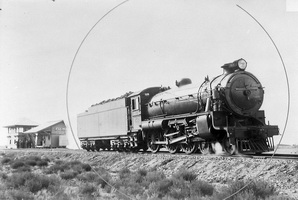
These railways are administered by the Commonwealth Railways Commissioner, whose office, with that of the Secretary of the Department and the Comptroller of Accounts and Audit and staff, is located in Melbourne. The general organisation is directed by officers who are responsible to the Commissioner for supervision of operations as described below:-
Offices and Workshops at Port Augusta.
The whole of the administration of the North Australia Railway is under the direct supervision of the Manager, with office and staff at Darwin. The organisation is shown in detail on the annexed chart in comparison with that necessary when the Railway were at peak war-time capacity.
The declaration of a state of war in 1939 introduced problems and difficulties in railway working which were common to all railways, but many also which were peculiar to each particular railway. It is proposed, therefore, that the effects of war conditions should be described in sections -
A broad indication of the demand made on these railways as a whole is given in the following tables showing the train mileage run and the total staff employed during the years of the war:-
| Train Mileage | Year ended 30th June | ||||||
|---|---|---|---|---|---|---|---|
| 1939 | 1940 | 1941 | 1942 | 1943 | 1944 | 1945 | |
| T.A.R C.A.R N.A.R A.C.T.R |
577,156 282,181 32,364 10,215 |
624,269 290,405 32,501 10,430 |
714,414 423,830 84,883 10,585 |
944,688 1,103,074 263,203 10,955 |
1,182,231 1,742,547 536,779 11,315 |
846,532 1,854,747 741,527 9,770 |
831,988 1,050,334 534,508 8,855 |
| 901,916 | 957,605 | 1,233,712 | 2,321,920 | 3,472,872 | 3,452,576 | 2,425,685 | |
| Total Staff | 1,943 | 2,138 | 2,131 | 2,446 | 3,152 | 3,506 | 3,329 |
During the years 1939 and 1940 it appeared that the greatest demand for service from the Commonwealth Railways would be on the Trans-Australian Railway, and long-range plans were made for enlargement of its capacity. These plans were subsequently curtailed as Australia's preparations for defence became centred on the Pacific theatre of war. Traffic on both the Trans-Australian and Central Australia Railways showed some increase during these two years. During 1940, equipment was railed to Alice Springs by the Department of the Army for construction of an all-weather road to Birdum, the southern terminal of the North Australia Railway to provide an alternative to the sea route to Darwin. Following the opening of this road, troops and equipment were moved in great volumes over the Central Australia Railway to Alice Springs, thence by the road to Birdum and rail to Darwin.
But it was upon the entry of Japan into the war in 1941 that activities on both railways were accelerated to a degree to cope with the great increase in traffic which was with precedent in their history. The Trans-Australian Railway, although its traffic was doubled, became of lesser importance when compared with the Central Australia Railway, on which the train mileage reached a figure between six and seven times greater than that of the last pre-war year.
As the whole locomotive power on these railways was steam-drive, and the country through which they passed was arid, the most important problem was water supply. On the East-West line, surface storage of water was such that, in normal times, it was common for all reservoirs to be exhausted at least for part of each year, and recourse to underground supplies was necessary. It has been stated that on no other railway in the world are the supplies of underground water more deleterious to locomotive boilers than those which, at times, must of necessity be used on the Trans-Australian Railway. On one stretch of more than 400 miles, there is no permanent source of supply.
To meet the rapidly growing service a large programme of expansion of water supplied was undertaken. Reservoirs were built and enlarged, bores were suck, water treatment and pumping plants were installed, tank storage was increased. Details of this work will be given later under the headings of the separate railways.
Coal requirements were shipped or railed from New South Wales to Port Pirie or Port Augusta. The quantity used on these two railways rose from 30,844 tons in the year ended 30th June, 1939 (pre-war), to 104,098 in the year ended 30th June, 1944.
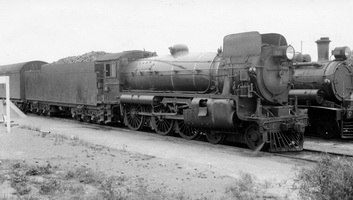
The increasing need for more and more coal during the war years was a constant source of anxiety. Shipping was, of course, greatly restricted, and hauling the coal by rail via Broken Hill entailed high expense and delays attendant on transfer of the coal at Broken Hill from standard to narrow gauge rail trucks. Railed coal from the Trans-Australian Railway was routed via Quorn to Port Augusta, where it was again transferred to standard gauge vehicles for transport to storage points along the railway.
To add to these difficulties, the coal supplied during the war was of an inferior quality. In normal times coal for these railways was supplied under contract, to the following specifications:-
The extent to which supplied deteriorated during wartime is illustrated in the following typical analysis in which the figures under "(a)" represent coal supplied under contract, and those under "(b)" coal received during the war:-
| (a) | (b) | |
|---|---|---|
| Ash content | 2.5% | 23.75% |
| Moisture | 6.8% | 1.3% |
| Calorific value | 13,500 B.T.U. | 11,070 B.T.U. |
The greater consumption of this coal entailed increased tonnages to be shipped or railed at a time when loading space was vital, and consequently added to the difficulty of maintaining supplied. Furthermore, substantial waste resulted from the used of unscreened coal in high-draught locomotive engines, and smoke boxes required greater maintenance.
The maintenance of locomotive and other rollingstock used in the increased services placed a great strain on the workshops staff and facilities. The procurement of additional machine tools and equipment, due to universal shortages, lagged at all times behind the increasing demand. Difficulties and delays associated with obtaining material supplies, also common throughout Australia during this period, added much to the burden of keeping the rollingstock in condition to withstand the strain of the unprecedented traffic.
In the matter of material supplied for workshops, buildings, track maintenance, etc., although the highest priority was granted for Commonwealth Railways requirements, there were many disheartening delays to urgent projects of all kinds during the critical years 1942/43.
Additional locomotives and other rollingstock were of prime and urgent importance and were obtained on loan or purchased from State railway systems, or purchased from any other available source. Details, and difficulties encountered, will be describe later in this article.
Difficulties in obtaining enough suitable staff were common to all organisations in Australia during the war period.
Railway organisations are, of course, very different from most commercial organisations in which many grades of skilled workers are more or less interchangeable. The only services from which the train running staff, for example, could be augmented at short notice, were from other railway systems, or by the release from the Defence Forces of men with railway operating experience.
More intensive maintenance of the tracks was necessary as the wartime traffic increased in volume; and fettling gangs had to be strengthened. For this work, perhaps more than any other phase of the operations, the search for men was unceasing. Every possible avenue was explored.
It was fortunate that the gangs on the Trans-Australian Railway had been strengthened in the year 1938/39 consequent upon the introduction of "C" class locomotives, with a maximum speed increased from 45 to 60 miles per hour. The number of gangs had been increased from 46 to 58. In the year 1939/40 the gangs were still further built up, and a heavy programme of re-sleepering and ballasting was carried out.
From May 1940, men began to drift away. Enlistments in the Defence Forces, and the attractions of higher wages and better amenities offering in the cities, claimed large numbers of the track staff.
The track forces had dropped to a dangerous degree when, in February 1942, the Commonwealth Railways was declared a protected undertaking under National Security (Manpower) Regulations. Advertisements in the newspapers, broadcasting on the National Radio stations, and notices at Police stations, were used to attract men. The maximum age at which new employees could be engaged was extended from 50 to 55 years, the eyesight test was reduced, and the severe medical test was dispensed with. In March 1942, Army Headquarters agreed to allow prospective military trainees, married and under the age of 35 years, the alternative of joining the Commonwealth Railways as civilian employees, if this were preferable to serving with the Forces. But all these efforts produced almost negligible results.
In April 1942, approximately 300 Italian prisoners of war were put to work on the Trans-Australian Railway to expedite sleeper renewals. These men were placed at six locations where camps had been prepared fro them. Two gangs were established at each place, comprising approximately -
A Military camp was established at Cook (about the centre of the line) for the headquarters staff. During the twenty months the prisoners of war were engaged on this line, the highest effective strength was 240. By 10.4.1943, the total number was reduced to 182, with an effective working strength of 145. As 170 Army Officers and other ranks were engaged as Military Guards (inclusive of headquarters staff), the men were returned to Army custody, and members of the Civil Aliens Corps were obtained in replacement.
The main difficulty found with the employment of prisoners of war was that they had to be assembled in large gangs and could therefore only be engaged on resleepering or similar work involving considerable labor over comparatively short mileages. Owing to the large Army guard required for these prisoners, the supply camps, water, equipment, etc. were greatly in excess of that which was normal for other classes of labor. Also, the need for skilled gangers and fettlers to direct and guide the inexperienced prisoners was a severe drain on manpower needed for other work.
The relations between the railway gangers and fettlers on the one hand, and the prisoners and Army personnel on the other, were generally good. The gangers directed the work, and it was only when prisoners refused to obey orders that the Military guards had cause to interfere.
It was found that the rations provided for the prisoners, which were normal for internees, were inadequate for men engaged on the heavy work or track maintenance, and an improved diet was arranged for them with an increased meat allowance.
Payment was made to the Department of the Army on the basis of Award rates for all work done by the prisoners.
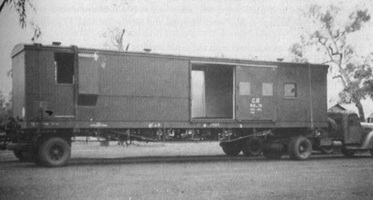
Men were first obtained from the Civil Aliens Corps in February 1943, and over the whole period of their employment 756 men were engaged for varying periods. The greatest number employed at any one time was 461, in September 1944.
Labor of this class was not as efficient as that engaged through normal channels. A great number of the men had never before carried out work of such an arduous nature, and being conscripted, they had no heart for the work. However, the maintenance of the track and the laying of new sidings, with the restricted field from which labor could be drawn, would probably have been impossible of achievement without their services.
A small minority of these aliens refused to work, and it was difficult to deal with them. Had it been possible to have had them re-interned for insubordination, the position would have been easier.
The Civil Aliens Corps was disbanded as from 16.6.1945, and those members who remained with these Railways were subject then to normal industrial conditions of employment.
Fettlers for the Ways and Works Branch could be recruited from unskilled and inexperienced labor available, but there was a serious lack of men capable of taking charge of a maintenance gang, or of giving assistance to the ganger when the gang was composed largely of untrained men. As a result of the Manpower Conference on 24.8.1942, 87 experienced gangers and fettlers were obtained on loan from State Railway systems.
Volunteers were also obtained for skilled work in the Mechanical Engineering and Transportation Branches.
In February 1941, volunteer engine crews were obtained to cope with the increased traffic expected on the Trans-Australian Railway but which did not eventuate. They were all returned by 29th May, 1941. However, in December of that year it was found that crews were urgently needed on the Central Australia Railway, and, at the same time, additional skilled tradesmen were greatly needed in the workshops. Application was accordingly made for volunteer engine crews and tradesmen.
Additional experienced traffic employees were also needed and volunteers for this class of duty were also sought in February 1942.
The response to appeals for volunteers is indicated in the following table:-
| Year Ended 30th June | Total number of Volunteers Employed | Total | |||
|---|---|---|---|---|---|
| Ways and Works Branch | Mechanical Branch | Transportation Branch | |||
| Wages | Wages | Wages | Sal. | ||
| 1942 | - | 99 | 42 | 3 | 144 |
| 1943 | 87 | 270 | 83 | 17 | 457 |
| 1944 | 31 | 190 | 78 | 13 | 312 |
| 1945 | 3 | 137 | 50 | 9 | 199 |
The shortage of staff in all sections resulted in much overtime being worked.
On the Trans-Australian Railway the hours worked for the track forces were increased by 45 minutes daily from 15th December 1941, and clearance of leave was restricted.
In the Port Augusta workshops as much as 56 hours per week were worked in some sections. The volume of work in the machine shop made it necessary to work two shifts.
Train running employees, drivers, firemen, guards and section staff were called upon during the peak period of the war to work hours that were really approaching the limits of endurance.
During this time, there were but slight increases in the numerical strength of the administrative staffs, and the strain of wartime was accordingly very heavy on them.
It should be recorded that the manner in which the staff as a whole shouldered their heavy burdens these grim years reflected great credit upon them, and was a very substantial contribution to Australia's war effort.
Some use was made in the workshops of the wartime acceptance of "dilutee" labor. Experienced tradesmen's helpers were up-graded to fitters, boilermakers, machinists, etc. to help relieve the shortage of skilled men.
Limited relief of the staff shortage was gained by the employment in 1943 of female car cleaners and engine cleaners. A total of 33 women were employed in the peak year.
It was of considerable help to this Department that the Commonwealth Railways was declared in February 1942 a protected undertaking under the National Security (Manpower) Regulations. This arrested the steadily increasing drain on staff caused by enlistments and the pursuit of higher wages.
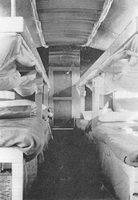

At the outbreak of war, special precautionary measures were taken to watch vulnerable points on these railways during the hours of darkness - Port Augusta Workshops, Wharf Pumps, Station Building at Port Augusta, Locomotive Depots at Port Pirie Junction, Quorn and Parkeston. At Yorkeys Crossing Bridge, situated about seven miles from Port Augusta and carrying the railway permanent way across Spencers Gulf, a continuous watch was maintained. Special instructions were issued for the safe-keeping of documents, plans and forms which would be of value to enemy agents.
Following a review of these precautions by the Department of the Army, it was decided that the railways were not of sufficient strategic importance to warrant the employment of Military guards, and on 27.10.1939 all special watchmen were withdrawn.
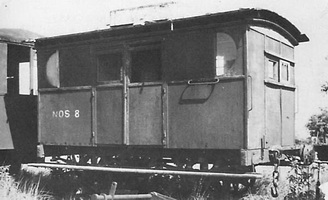
Blackout conditions were imposed in February 1942 on buildings, streets, trains, etc.. Station name-boards were removed from stations between Port Pirie Junction and Pimba, and Ooldea and Forrest on the Trans-Australian Railway, and between Port Augusta and Brachina on the Central Australia Railway.
On 13th July 1942, it was decided to remove black-out paint from the windows on the Port Augusta workshops and, as an alternative precaution, it was arranged that all lights would be switched off in the event of an air raid warning being given.
During the war period it was necessary to increase the supervising of staff as follows:-
The position of Senior Roadmaster was created on 24.10.1941.
To provide relief of the burden of administration for this Branch, it was arranged in April 1943, through the courtesy of the South Australian Railways, for four of their technical officers to be made available to this Department. Their Chief Mechanical Engineer was attached, part-time, as Technical Assistant to the Commissioner. The Acting Locomotive Superintendent, South Australian Railways, Peterborough Division, was attached part-time supervising the locomotive running section; and one Boiler Inspector and one Locomotive Running Officer were loaned for full-time duty.
During the period 1942/43 supervision of the locomotive running section was sub-divided until on 9.6.1943 the following offices existed:-
| Trans-Australian Railway | ||
|---|---|---|
| Eastern Division - Port Pirie Junction to Barton (inclusive) | ||
| Loco. Superintendent Travelling Foreman Running Inspectors |
1 1 2 |
|
| Western Division - Barton (exclusive) to Kalgoorlie | ||
| Loco. Superintendent Travelling Foreman Running Inspectors |
1 1 2 |
|
| Central Australia Railway | |
|---|---|
| Loco. Superintendent Travelling Foreman Running Inspectors |
1 1 2 |
In the workshops, the position of Works Manger, four additional foremen, Plant Engineer, and Production Officer, were created to provide more effective supervision.
On 1.7.1940 appointments were made to the positions of Senior Traffic Inspector and Traffic Inspector.
On 7.4.1941 the supervision of train running staff was strengthened by the position of a Traffic Superintendent. This duty was later divided into two positions - Traffic Superintendents, Trans-Australian and Central Australia Railways; and a further position was created - Chief Train Controller and Timetables Officer.